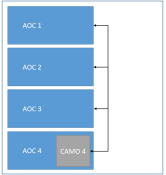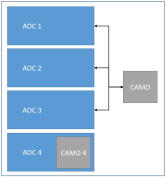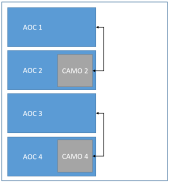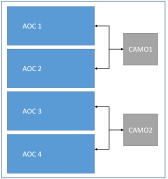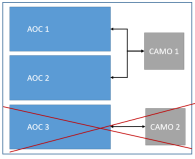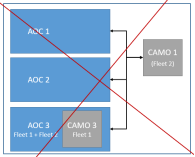Regulation (EU) 2019/1383
(a) The owner of the aircraft shall be responsible for the continuing airworthiness of aircraft and shall ensure that no flight takes place unless all of the following requirements are met:
(1) the aircraft is maintained in an airworthy condition;
(2) any operational and emergency equipment fitted is correctly installed and serviceable or clearly identified as unserviceable;
(3) the airworthiness certificate is valid;
(4) the maintenance of the aircraft is performed in accordance with the AMP specified in point M.A.302.
Regulation (EU) No 1321/2014
(b) When the aircraft is leased, the responsibilities of the owner are transferred to the lessee if:
1. the lessee is stipulated on the registration document; or
2. detailed in the leasing contract.
When reference is made in this Part to the ‘owner’, the term owner covers the owner or the lessee, as applicable.
Regulation (EU) No 1321/2014
(c) Any person or organisation performing maintenance shall be responsible for the tasks performed.
Regulation (EU) 2019/1383
(d) The pilot-in-command or, in the case of aircraft used by air carriers licensed in accordance with Regulation (EC) No 1008/2008, the operator, shall be responsible for the satisfactory accomplishment of the pre-flight inspection. That inspection shall be carried out by the pilot or another qualified person and shall not need to be carried out by an approved maintenance organisation or by certifying staff.
Regulation (EU) 2020/270
(e) In the case of aircraft used by air carriers licensed in accordance with Regulation (EC) No 1008/200825 Regulation (EC) No 1008/2008 of the European Parliament and of the Council of 24 September 2008 on common rules for the operation of air services in the Community (OJ L 293, 31.10.2008, p. 3). the operator shall be responsible for the continuing airworthiness of the aircraft it operates and shall:
(1) ensure that no flight takes place unless the conditions set out in point (a) are met;
(2) take the necessary steps to ensure its approval as a continuing airworthiness management organisation (‘CAMO’) pursuant to Annex Vc (Part-CAMO) or Subpart G of this Annex (Part-M), as part of air operator certificate for the aircraft it operates;
(3) take the necessary steps to ensure its approval in accordance with Annex II (Part-145) or conclude a written contract in accordance with point CAMO.A.315(c) of Annex Vc (Part-CAMO) or point M.A.708(c) of this Annex (Part-M) with an organisation which has been approved in accordance with Annex II (Part-145).
Regulation (EU) 2022/410
(ea) By derogation to point (e)(2), at least two operators forming part of a single air carrier business grouping may use the same CAMO to assume the responsibility for the continuing airworthiness management of all the aircraft they operate, provided that all of the following requirements are met:
(1) the CAMO is approved in accordance with Annex Vc (Part-CAMO) for the aircraft to be managed;
(2) the CAMO forms part of the same air carrier business grouping as the operators concerned;
(3) a contract is established in accordance with Appendix I to this Annex between the CAMO and the AOC holder not itself approved as a CAMO;
(4) the CAMO has its principal place of business in the territory to which the Treaties apply;
(5) the individual management systems of the organisations concluding a contract are harmonised with each other.
Regulation (EU) 2022/410
(eb) By derogation to point (e)(2), when the termination or revocation of an air operator certificate results in a situation where an air carrier licensed in accordance with Regulation (EC) No 1008/2008 and forming part of an air carrier business grouping is no longer in compliance with point M.A.201(ea), that licensed air carrier shall define and implement an action plan to the satisfaction of the competent authority to comply with point M.A.201(e)(2) as soon as practicable.
Regulation (EU) 2020/270
(f) For complex motor-powered aircraft used for commercial specialised operations, for CAT operations other than those performed by air carriers licensed in accordance with Regulation (EC) No 1008/2008 or by commercial Approved Training Organisations (‘ATO’) and Declared Training Organisations (‘DTO’) referred to in Article 10a of Regulation (EU) No 1178/201126 Commission Regulation (EU) No 1178/2011 of 3 November 2011 laying down technical requirements and administrative procedures related to civil aviation aircrew pursuant to Regulation (EC) No 216/2008 of the European Parliament and of the Council (OJ L 311, 25.11.2011, p. 1)., the operator shall ensure that:
(1) no flight takes place unless the conditions set out in point (a) are met;
(2) the tasks associated with continuing airworthiness are performed by a CAMO approved in accordance with Annex Vc (Part-CAMO) or Subpart G of this Annex (Part-M); when the operator is not a CAMO approved in accordance with Annex Vc (Part-CAMO) or Subpart G of this Annex (Part-M), it shall conclude a written contract as regards the performance of those tasks in accordance with Appendix I to this Annex with an organisation approved in accordance with Annex Vc (Part-CAMO) or Subpart G of this Annex (Part-M);
(3) the CAMO referred to in point (2) is approved in accordance with Annex II (Part-145) as an organisation to qualify for the issue of an approval for the maintenance of aircraft and of components for installation thereon, or that CAMO has concluded a written contract in accordance with point CAMO.A.315(c) of Annex Vc (Part-CAMO) or point M.A.708(c) of this Annex (Part-M) with organisations approved in accordance with Annex II (Part-145).
Regulation (EU) 2020/270
(g) For complex motor-powered aircraft not included in points (e) and (f), the owner shall ensure that:
(1) no flight takes place unless the conditions set out in point (a) are met;
(2) the tasks associated with continuing airworthiness are performed by a CAMO approved in accordance with Annex Vc (Part-CAMO) or Subpart G of this Annex (Part-M); when the owner is not a CAMO approved in accordance with Annex Vc (Part-CAMO) or Subpart G of this Annex (Part-M), it shall conclude a written contract as regards the performance of those tasks in accordance with Appendix I to this Annex with an organisation approved in accordance with Annex Vc (Part-CAMO) or Subpart G of this Annex (Part-M);
(3) the CAMO referred to in point (2) is approved in accordance with Annex II (Part-145) as an organisation to qualify for the issue of an approval for the maintenance of aircraft and of components for installation thereon, or that CAMO has concluded a written contract in accordance with point CAMO.A.315(c) of Annex Vc (Part-CAMO) or point M.A.708(c) of this Annex (Part-M) with organisations approved in accordance with Annex II (Part-145).
Regulation (EU) 2021/700
(h) For aircraft other than complex motor-powered aircraft used for commercial specialised operations or for CAT operations other than those performed by air carriers licensed in accordance with Regulation (EC) No 1008/2008, or by commercial ATOs and commercial DTOs referred to in Article 10a of Regulation (EU) No 1178/2011, the operator shall ensure that:
(1) no flight takes place unless the conditions set out in point (a) are met;
(2) the tasks associated with continuing airworthiness are performed by a CAMO approved in accordance with Annex Vc (Part-CAMO) or Subpart G of this Annex (Part-M), or a combined airworthiness organisation (‘CAO’) approved in accordance with Annex Vd (Part-CAO); when the operator is not a CAMO approved in accordance with Annex Vc (Part-CAMO) or Subpart G of this Annex (Part-M), or a CAO approved in accordance with Annex Vd (Part-CAO), it shall conclude a written contract in accordance with Appendix I to this Annex with a CAMO approved in accordance with Annex Vc (Part-CAMO) or Subpart G of this Annex (Part-M), or a CAO approved in accordance with Annex Vd (Part-CAO);
(3) the CAMO or CAO referred to in point (2) is approved in accordance with Annex II (Part-145) or in accordance with Subpart F of this Annex (Part-M) or as a CAO with maintenance privileges, or that CAMO or CAO has concluded a written contract with organisations approved in accordance with Annex II (Part-145) or in accordance with Subpart F of this Annex (Part-M) or Annex Vd (Part-CAO) with maintenance privileges.
Regulation (EU) 2020/270
(i) For aircraft other than complex motor-powered aircraft not included in points (e) and (h), or used for limited operations, the owner shall ensure that flight takes place only if the conditions set out in point (a) are met. To that end, the owner shall:
(1) attribute the continuing airworthiness tasks referred to in point M.A.301 to a CAMO or CAO through a written contract concluded in accordance with Appendix I; or
(2) carry out those tasks himself; or
(3) carry out those tasks himself except the tasks of the development of and the processing of the approval of the AMP, only if those tasks are performed by a CAMO or CAO through a limited contract concluded in accordance with point M.A.302.
Regulation (EU) 2015/1536
(j) The owner/operator shall ensure that any person authorised by the competent authority is granted access to any of its facilities, aircraft or documents related to its activities, including any subcontracted activities, to determine compliance with this Part.
Regulation (EU) 2020/270
(k) Where an aircraft included in an air operator certificate is used for non-commercial operations or specialised operations under point ORO.GEN.310 of Annex III or point NCO.GEN.104 of Annex VII to Regulation (EU) No 965/2012, the operator shall ensure that the tasks associated with continuing airworthiness are performed by the CAMO approved in accordance with Annex Vc (Part-CAMO) or Subpart G of this Annex (Part-M) or the combined airworthiness organisation (“CAO”) approved in accordance with Annex Vd (Part-CAO), whichever applicable, of the air operator certificate holder.
ED Decision 2022/017/R
|
Select your type of operation |
Complex |
Other-than-complex motor-powered aircraft (aircraft subject to Part ML are excluded here) |
||||
|
Is a CAMO or CAO required for the management of continuing airworthiness? |
Is maintenance by a maintenance organisation required? |
Is a CAMO or CAO required for the management of continuing airworthiness? |
Is maintenance by a maintenance organisation required? |
|||
|
Air carriers licensed in accordance with Regulation (EC) No 1008/2008 |
Yes, a CAMO is required. It shall be part of the AOC (M.A.201(e)) unless point M.A.201(ea) applies. |
Yes, maintenance by a Part-145 organisation is required |
Yes, a CAMO is required. It shall be part of the AOC (M.A.201(e)) unless point M.A.201(ea) applies. |
Yes, maintenance by a Part-145 organisation is required |
||
|
CAT other than air carriers licensed in accordance with Regulation (EC) No 1008/2008 |
Yes, a CAMO is required |
Yes, maintenance by a Part-145 organisation is required |
Yes, a CAMO or CAO is required |
Yes, maintenance by a Subpart F, by a Part-CAO or by a Part-145 organisation is required |
||
|
Commercial specialised operations |
Yes, a CAMO is required |
Yes, maintenance by a Part-145 organisation is required |
Yes, a CAMO or CAO is required |
Yes, maintenance by a Subpart F, by a Part-CAO or by a Part-145 organisation is required |
||
|
Commercial training organisations (ATOs) |
Yes, a CAMO is required |
Yes, maintenance by a Part-145 organisation is required |
Yes, a CAMO or CAO is required |
Yes, maintenance by a Subpart F, by a Part-CAO or by a Part-145 organisation is required |
||
|
Other than commercial operations including limited operations as defined in Article 2(p) |
Yes, a CAMO is required |
Yes, maintenance by a Part-145 organisation is required |
No, a CAMO or CAO is not required |
No, maintenance by a Subpart F, by a Part-CAO or Part-145 organisation is not always required |
||
GM M.A.201(e) Responsibilities
ED Decision 2016/011/R
The performance of ground de-icing and anti-icing activities does not require a Part-145 maintenance organisation approval. Nevertheless, inspections required to detect and, when necessary, remove de-icing and/or anti-icing fluid residues are considered maintenance. Such inspections may only be carried out by suitably authorised personnel.
AMC M.A.201(e)(2) Responsibilities
ED Decision 2016/011/R
1. An air carrier licensed in accordance with Regulation (EC) No 1008/2008 only needs to hold a CAMO approval as part of its air operator certificate (AOC) for the management of the continuing airworthiness of the aircraft listed on its AOC. The approval to carry out airworthiness reviews is optional.
2. Part-M does not provide for CAMOs to be independently approved to perform continuing airworthiness management tasks on behalf of air carriers licensed in accordance with Regulation (EC) No 1008/2008. The approval of such activity is vested in the (AOC).
3. The operator is ultimately responsible and, therefore, accountable for the airworthiness of its aircraft.
AMC1 M.A.201(ea) Responsibilities
ED Decision 2022/017/R
HARMONISATION OF THE MANAGEMENT SYSTEMS
(a) The harmonised management systems of the organisations that conclude a contract should encompass safety by including the following elements:
(1) A forum to share the results and conclusions of the safety review boards (SRBs) of each organisation, which should be attended by the accountable managers, safety managers, and any other relevant nominated person(s). That forum may for example take the form of regular joint meetings of the organisations’ SRBs.
(2) Regular exchange between the organisations of the results and conclusions of the compliance monitoring function as well as of the results of the oversight of each organisation by the CA(s). The exchange of information on compliance monitoring and oversight provides for awareness, analysis, and hazard identification.
(3) A common or consistent safety policy and its related safety objectives.
Note: establishing common or consistent safety objectives does not prevent the organisation(s) from defining additional and/or specific safety objectives to adapt to the local environment/specificities/operations and/or to the organisation safety performance, as applicable.
(4) Common or consistent safety management key processes (see AMC1 CAMO.A.200(a)(3) ‘Management system’) that are established by the CAMO and its contracting operators unless those processes relate to activities or procedures that are specific to one of those organisations (e.g. fatigue risk management system (FRMS)).
(5) A cooperation mechanism to ensure prompt reaction when one of the organisations shares some serious concerns with another organisation.
(6) A cooperation mechanism to ensure proper actions are coordinated at group level if there are findings at one organisation, which affect the harmonisation of the management systems.
(7) A cooperation mechanism with the operator(s) to manage the changes in the harmonised elements of the management systems in such a way that those changes produce their effect at the same time.
(b) The CAMO/operator(s)’ procedures should describe how the interface and harmonisation between the management systems are achieved, and specify the records to be retained in respect of the harmonisation of the management systems.
AMC2 M.A.201(ea) Responsibilities
ED Decision 2022/017/R
To ensure that all parties involved can fulfil their responsibilities, all manuals, procedures, and communication between them should be, at least, in one common language, e.g. English, when the CAMO manages the continuing airworthiness of aircraft registered in (a) different Member State(s) than its principal place of business. Parties involved include the competent authority(ies) with which that common language should be agreed upon.
GM1 M.A.201(ea) Responsibilities
ED Decision 2022/017/R
HARMONISATION OF THE MANAGEMENT SYSTEMS — GROUP STANDARDS AND CHANGES THERETO
(a) Depending on the size of the single air carrier business grouping and on the nature and complexity of its activities, an efficient way of harmonising the management systems of the organisations is by collectively developing group standards that are endorsed by a group management board or similar group governance body. Such group standards may include provisions for the monitoring of the obligations of the parties that have signed the contract established in accordance with Appendix I to Annex I (Part-M) to Regulation (EU) No 1321/2014.
(b) The group management board or similar group governance body is composed of the accountable managers of the organisations and a coordinating member. The names of the board members are included directly, or by reference to a common document, in the contract, and are updated in the respective document in case of change in personnel.
(c) The coordinating member may be one of the accountable managers or another person. As a consequence of applying point M.A.201(ea) is that several operators will use the same CAMO, the group management board may consider having as coordinating member one employee of that CAMO. The role of the coordinating member includes, but is not limited to the following:
ensuring that all perspectives are considered;
defining the by-laws of the board and ensuring they are complied with;
coordinating decision-making;
ensuring that the documentation is updated;
ensuring the review of the group standards;
ensuring the regular exchange of communication and that meetings take place; and
coordinating the integration of an organisation into, or, if applicable, its departure from, the business grouping.
(d) The group standards can be documented either:
in a common document that is cross-referenced in the continuing airworthiness management contract that is required by point M.A.201(ea); or
in the exposition/manual of each organisation, in which case the continuing airworthiness management contract that is required by point M.A.201(ea) should cross-reference the relevant part of the organisations’ expositions/manuals; or
in the continuing airworthiness management contract that is required by point M.A.201(ea).
(e) In particular, the group standards include:
methods and procedures to address the safety management key processes;
identification of the different operators and the CAMO;
identification and contact details of the members of the group management board or of the similar group governance body; and
management of the changes that affect the group standards, e.g. consultation process.
GM2 M.A.201(ea) Responsibilities
ED Decision 2022/017/R
AIR CARRIER BUSINESS GROUPING
The controlling undertaking exercises directly or indirectly a dominant influence over the controlled undertaking by virtue of ownership, financial participation, right to appoint management or a supervisory body, the rules that govern it, or other.
The controlled and controlling undertakings include air carriers licensed in accordance with Regulation (EC) 1008/200827 as well as one or more organisations that are approved in accordance with Annex Vc (Part-CAMO) to Regulation (EU) No 1321/2014.
In the frame of Community-scale groups of undertakings, Article 3 of Directive 2009/38/EC28 provides additional information about controlling undertakings, which can also be suitable to national-scale groups of undertakings.
(b) Each approved organisation is responsible for its management system, even if they follow common group standards, policies, or procedures. The accountability of each approved organisation, as defined by the relevant EU regulation, is not affected by being part of a single air carrier business grouping. The air carrier remains ultimately responsible for the continuing airworthiness of the aircraft it operates even if the operator decides to contract the continuing airworthiness management to a CAMO. In that case, the operator is no longer responsible for performing the continuing airworthiness tasks, as that responsibility is transferred to the contracted CAMO. The operator keeps the responsibility to fulfil the requirements in the EU regulations, e.g. to assess the CAMO to ensure that it has the capability and capacity to comply with the contract (see Part-M, Appendix I, point 7).
GM3 M.A.201(ea) Responsibilities
ED Decision 2022/017/R
CONFIGURATIONS
(a) Each AOC holder of a single air carrier business grouping may choose either to remain an approved CAMO itself (in accordance with point M.A.201(e)(2)) or to contract a CAMO (in accordance with point M.A.201(ea)).
(b) The following schemes illustrate possible examples of configurations:
|
Each AOC holder has a contract with the CAMO in accordance with point M.A.201(ea). |
|
|
|
AOC 1, AOC 2, and AOC 3 holders have a contract with CAMO 4 each (in accordance with point M.A.201(ea)); CAMO 4 is integrated into AOC 4 (in accordance with point M.A.201(e)(2)). |
|
|
AOC 1, AOC 2, and AOC 3 have a contract with a CAMO each (in accordance with point M.A.201(ea)); CAMO 4 is integrated into AOC 4 (in accordance with point M.A.201(e)(2)). |
|
|
AOC 1 has a contract with CAMO 2 (in accordance with point M.A.201(ea)), AOC 3 has a contract with CAMO 4 (in accordance with point M.A.201(ea)), while CAMO 2 and CAMO 4 remain respectively integrated into AOC 2 and AOC 4 (in accordance with point M.A.201(e)(2)). |
|
|
AOC 1 and AOC 2 have a contract with CAMO 1 each (in accordance with point M.A.201(ea)); AOC3 and AOC4 have a contract with CAMO 2 each (in accordance with point M.A.201(ea)). |
|
|
AOC 1 has a contract with CAMO 2 (in accordance with point M.A.201(ea)); CAMO 2 remains integrated into AOC 2 (in accordance with point M.A.201(e)(2)). |
(c) The following schemes illustrate examples of configurations that are not compliant with point M.A.201(ea) (non exhaustive list):
|
|
This configuration is not compliant with point M.A.201(ea) because only one AOC (i.e. AOC 1) uses the contracted CAMO. |
|
|
This configuration is not compliant with point M.A.201(ea) because only one AOC (i.e. AOC 3) uses the contracted CAMO (i.e. CAMO 2). |
|
|
This configuration is not compliant with point M.A.201(ea) because CAMO 1 is not contracted by the AOC holders (i.e. AOC 1 and AOC 2) for all the aircraft they operate. |
|
|
This configuration is not compliant with point M.A.201(ea) because CAMO 1 is not contracted by AOC 3 for all the aircraft it operates. |
GM M.A.201(i) Aircraft maintenance programme
ED Decision 2016/011/R
If an owner decides not to make a contract in accordance with M.A.201(i), the owner is fully responsible for the proper accomplishment of the corresponding tasks. As a consequence, it is recommended that the owner properly self-assesses his/her own competence to accomplish them or otherwise seeks the proper expertise.
AMC M.A.201(i)(3) Responsibilities
ED Decision 2020/002/R
LIMITED CONTRACT FOR THE DEVELOPMENT OF THE AMP
The limited contract for the development and, when applicable, processing of the approval of the aircraft maintenance programme should cover the responsibilities related to M.A.302(d), M.A.302(f) and M.A.302(h).
GM1 M.A.201(k) Responsibilities
ED Decision 2020/002/R
USE OF AIRCRAFT INCLUDED IN AN AOC FOR NCO OR SPO
As point (k) is not a derogation from the previous points of M.A.201, points M.A.201(f), (g), (h) and (i) are still applicable.
Regulation (EU) 2019/1383
(a) Without prejudice to the reporting requirements set out in Annex II (Part-145) and Annex Vc (Part-CAMO), any person or organisation responsible in accordance with point M.A.201 shall report any identified condition of an aircraft or component which endangers flight safety to:
(1) the competent authority designated by the Member State of registry of the aircraft, and, when different to the Member State of registry, to the competent authority designated by the Member State of the operator;
(2) to the organisation responsible for the type design or supplemental type design.
(b) The reports referred to in point (a) shall be made in a manner determined by the competent authority referred to in point (a) and shall contain all pertinent information about the condition known to the person or organisation making the report.
(c) Where the maintenance or the airworthiness review of the aircraft is carried out on the basis of a written contract, the person or the organisation responsible for those activities shall also report any condition referred to in point (a) to the owner and the operator of the aircraft and, when different, to the CAMO or CAO concerned.
(d) The person or organisation shall submit the reports referred to in points (a) and (c) as soon as possible, but no later than 72 hours from the moment when the person or organisation identified the condition to which the report relates, unless exceptional circumstances prevent this.
(e) The person or organisation shall submit a follow-up report, providing details of actions which that person or organisation intends to take to prevent similar occurrences in the future, as soon as those actions have been identified. The follow-up report shall be submitted in a form and manner established by the competent authority.
AMC M.A.202(a) Occurrence reporting
ED Decision 2023/013/R
Accountable persons or organisations should ensure that the type certificate (TC) holder or the declarant of a declaration of design compliance receives adequate reports of occurrences for that aircraft type, to enable it to issue appropriate service instructions and recommendations to all owners or operators.
Liaison with the TC holder or the declarant of a declaration of design compliance is recommended to establish whether published or proposed service information will resolve a problem or to obtain a solution to a particular problem.
An approved continuing airworthiness management or maintenance organisation should assign responsibility for co-ordinating action on airworthiness occurrences and for initiating any necessary further investigation and follow-up activity to a suitably qualified person with clearly defined authority and status.
In respect of maintenance, reporting a condition which endangers flight safety is normally limited to:
serious cracks, permanent deformation, burning or serious corrosion of structure found during scheduled maintenance of the aircraft or component.
failure of any emergency system during scheduled testing.
AMC M.A.202(b) Occurrence reporting
ED Decision 2015/029/R
The reports may be transmitted by any method, i.e. electronically, by post or by facsimile.
Each report should contain at least the following information:
reporter or organisation’s name and approval reference if applicable,
information necessary to identify the subject aircraft and/or component,
date and time relative to any life or overhaul limitation in terms of flying hours/cycles/landings etc., as appropriate,
details of the occurrence.
AMC 20-8 General Acceptable Means of Compliance for Airworthiness of Products, Parts and Appliances provides further guidance on occurrence reporting.

